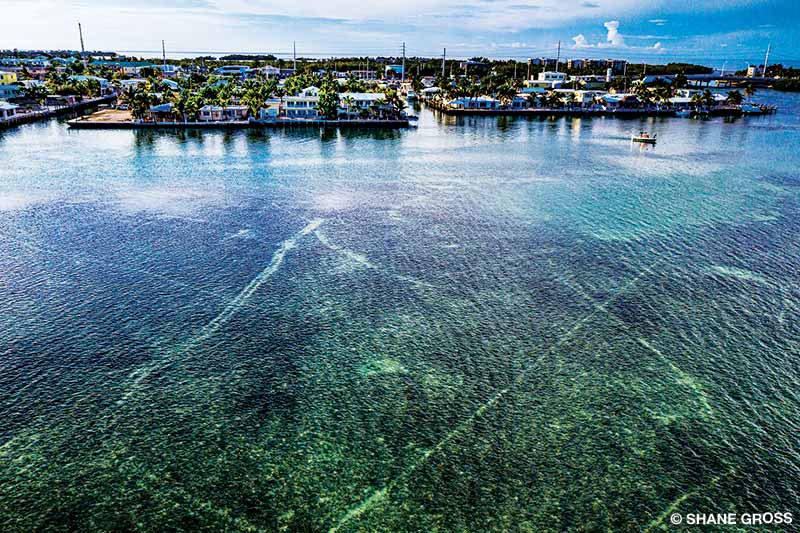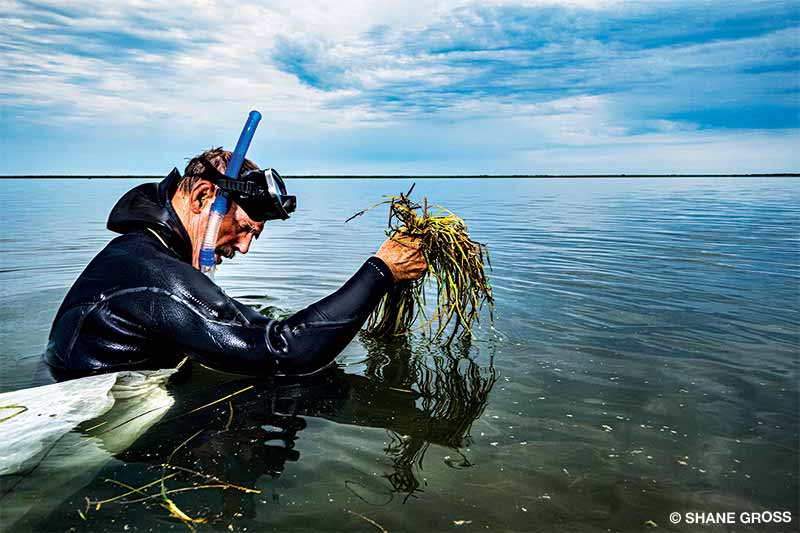Why protecting this disappearing marine plant is vital in our fight to save the climate and biodiversity.
I lifted the rock, and my key was gone. It was high noon in July, and the Florida Keys heat was oppressive. I was dripping salt water and had seaweed in my hair. My cellphone, wallet, drinking water, hotel key, sunglasses and everything else except my wet board shorts and underwater camera were sealed in the hot rental car. I knew I had put the key fob there, and I had watched the area from my spot in the water. Nobody could have taken it, and I wondered in disbelief where on earth it could be.
I had been sitting in a seagrass meadow, hoping a shy bonnethead shark would swim in front of my lens. These small hammerheads were reclassified in 2018 as the world’s first known omnivorous sharks. A central question facing scientists was how much of the seagrass nutrient content the sharks were taking in.
In one study led by Samantha Leigh, Ph.D., of California State University, Dominguez Hills, researchers fed captive bonnethead sharks a 90 percent seagrass diet for three weeks. Analysis of the sharks’ digestion showed they could get nutrients from the seagrass and exhibit growth on a primarily vegetarian diet. Since other marine omnivores have had positive effects on food webs, the researchers posited that the sharks’ nutrient intake meant we would “need to reevaluate the roles of bonnethead sharks in seagrass ecology because they could be responsible for significant grazing and nutrient transport within fragile seagrass ecosystems.”1

Plant-eating sharks are just one example of how science changes our view of seagrass and reveals its importance.
Seagrasses are different from algae and seaweed; they are more akin to flowering plants that grow on land. About 72 species are found in coastal seas on every continent except Antarctica, stretching from the equator to cool and cold areas — some Zostera marina grows in the Arctic and can survive under ice.
A few weeks before I ended up keyless in the Florida heat, I was wearing a drysuit but still shivering in 35°F (1.7°C) water in Newfoundland, Canada. I had joined a small team of scientists from Fisheries and Oceans Canada (DFO) who have been monitoring the eelgrass and fish populations for decades.
In the early 1990s one of the world’s largest fisheries collapsed. A 1992 moratorium on cod fishing cost more than 30,000 jobs in Newfoundland. The Atlantic cod population had been mismanaged and was severely overfished. In the nearly 30 years since then, the population hasn’t returned to levels where commercial fishing can operate as it once did. Having ample seagrass habitats in which juveniles can hide and feed is one key to increasing cod numbers.

Many of the world’s major fisheries species depend on seagrass at some point in their life cycle. About 70 percent of the fishery species in Florida, for example, spend some time in seagrass.2
Like bonnetheads, Atlantic cod are shy around people. I set my underwater camera rig on a tripod in front of a lush patch of seagrass and backed away, as my freezing hand grasped the remote trigger.
A tiny Atlantic cod would occasionally flit in front of my lens, and I’d snap a picture. I joked with the team between dives and sips of hot chocolate how I was on my way to sunny Spain after this, simultaneously attempting to warm them up and make them jealous.
Off the Spanish coast of the Mediterranean Sea, I swam among one of the oldest and largest seagrass species on the planet — Posidonia oceanica. The plant’s root system is connected beneath the seafloor and stretches for more than 9 miles (14.5 km). Scientists estimate this organism could be up to 200,000 years old. The species is slow to recover from loss and has declined due to climate change and other human activity. Researchers are gathering data on its loss and areas where it is not declining, hoping that a better understanding will help reverse the trend.

Seagrass is in decline worldwide. Some estimates suggest an overall loss of up to 7 percent a year throughout the 1990s and early 2000s.3 Factors such as pollution, coastal development, reduced water clarity, certain fishing, mooring and boating practices, and, of course, climate change are among those contributing to the decline.
In May 2019 I joined a team of volunteers and researchers from the Virginia Institute of Marine Science (VIMS) as they continued a 20-year seagrass restoration project using a technique developed by VIMS professor Robert “JJ” Orth, Ph.D. His seeding system is incredibly effective and has reestablished more than 9,000 acres of healthy eelgrass that has shown signs of developing into a full ecosystem. This method may be promising for regrowth elsewhere, but protecting what we still have should be the priority.
The benefits of protecting seagrass cannot be overstated. Seagrass purifies the water, helps protect against coastal erosion, helps sustain small-scale fisheries that support communities, and increases fish populations and biodiversity. It sequesters much more carbon per area than terrestrial forests and reduces ocean acidification. Healthy seagrass means a healthier ocean.

With so much going for it, why aren’t dive tourists flocking to explore seagrass meadows? I’ve encountered toothy sharks and crocodiles, lovable dugongs and turtles, amazing seahorses and octopuses, strange lumpfish and horseshoe crabs, and many others among seagrass.
Back in Florida, a single bonnethead shark eventually swam up to my camera, took a quick look and disappeared. I had one usable photograph after nine days of patience. I never found my key. A crab probably dragged it down one of the many nearby holes — perhaps it was a bit of revenge from nature. If we let ourselves destroy too much of nature, I worry about its revenge against all of us. Let’s do what we can to protect our seagrass — that’s one key we don’t want to lose.
Notes
1. Leigh SC, Papastamatiou YP, German DP. Seagrass digestion by a notorious ‘carnivore.’ Proceedings of the Royal Society B. 2018; 285(1886). doi.org/10.1098/rspb.2018.1583. royalsocietypublishing.org/doi/full/10.1098/rspb.2018.1583
2. Importance of seagrass. Florida Fish and Wildlife Conservation Commission. myfwc.com/research/habitat/seagrasses/information/importance
3. Salinas C, Duarte CM, Lavery PS, et al. Seagrass losses since mid-20th century fueled CO2 emissions from soil carbon stocks. Global Change Biology 2020; 26(9):4772–4784. doi.org/10.1111/gcb.15204. onlinelibrary.wiley.com/doi/full/10.1111/gcb.15204
Explore More
Watch this video to learn more about the role of seagrass in climate change.
© Alert Diver — Q3/Q4 2021